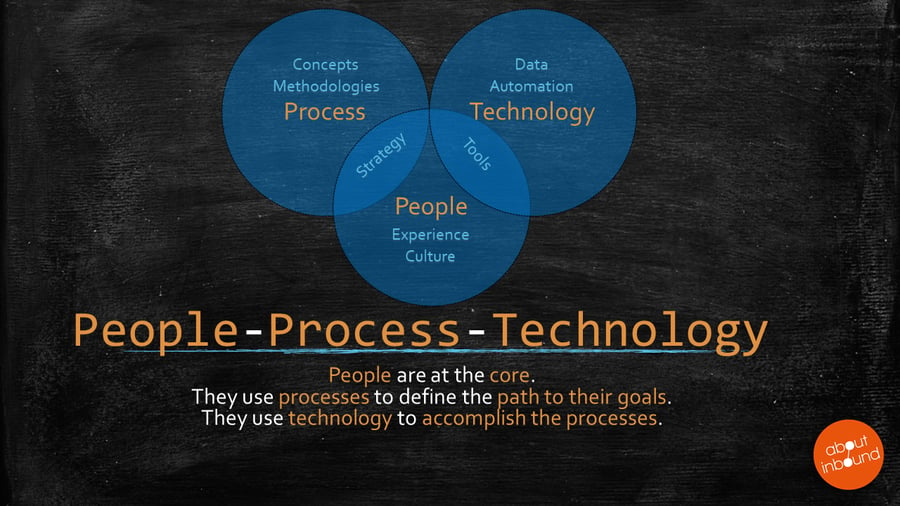Why it's good to be aware about methodologies and concepts?
It can be very hard for me to keep a clear grasp of how all the different Methodologies, concepts, tasks and buzzwords relate to each other and where to focus my attention. This a big problem for me as it affects the balance of my marketing and also service delivery related activities. At times, I get a sort of vertigo and get very confused about where I should focus my attention.
If I loose sight of our goals and principles I am likely to fail in the long term. If I focus too much on the long term and miss out on the daily activities that keep our marketing machine running, I fail immediately . To ensure I find a balance between these two ways of thinking and working I have to be able to see the bigger picture. The framework that I can place all these principles, tasks etc. into so that I can actually use them to reach our goals.
At About Inbound, we focus heavily on knowledge and communication. Our clients depend on us to give them clarity, quality and peace of mind, so in short, if I am not clear about what I am doing or about how to apply the concepts we sell, I am kind off.. well... useless.
To combat these moments of marketing research "vertigo" I often try to order my learning on paper or chat it through with Vourneen who is About Inbound's founder and ultimate super expert. This ordering of thoughts helps me make sense of it all and has over time allowed me to quickly grasp new concepts and approaches because I can visualize where they "sit" in the jungle that is modern growth marketing. I also noticed that many of our clients run into similar issues. They know many of the buzzwords and definitions but can't quite connect them together, or they are unable to apply them because they are too snowed under in their day-to-day tasks..
To help define some of the workings of a modern Growth strategy I decided to create a series of posts around it. I hope they can help you in your quest to keep your marketing growth stars aligned and making them work for you.
This post is part of a 4 part series to provide you with a better understanding of how to create growth strategy. You can find all for parts here: |
Why is it important to use methodologies for marketing and growth?
Let's ask ourselves a question. Why do we do what we do as marketers?
We want to drive awareness and capture interest to drive sales. We want our business to grow. This growth should be exponential. In other words, the level of growth should increase every year. to do this we need an approach that stimulates growth in all parts of the business, not just a single department. This calls for a bigger vision than just our departmental goals. We need to work together with all our colleagues across all departments, especially any customer facing ones. Communication is key.
So how to do you deal with this wider approach to successful business growth?
This is where methodologies and concepts come in to play.
What is a methodology and how can it be used to reach your business goals?
A methodology is a system to set goals and apply resources and tools across your organisation so you can reach those goals. A methodology can be used to demonstrate a concept and then give you the methods to apply it successfully.
In marketing, sales and other business growth methods, methodologies give you guidance to define your goals for growth and the processes to achieve them. They help to fit in everything from departments and individual job roles or tasks all the way to the use of tools and services to achieve those goals.
How do Marketing sales and Software Providers use methodologies?
Marketing and Sales Software companies use methodologies to provide an easy to understand concept of their tools and how they can be used to achieve more success. They want to give you the right methods and procedures to use their tools. They want to educate you to apply them successfully. If they can achieve this, you will become a long term proponent of their products and services. You will promote their brand and their approach.
In Simon Sinek words:
"It's not what you do, but why you do what you do"
A methodology helps with the why.
Examples of methodologies used by Marketing service providers:
Hubspot heavily uses the term Inbound Methodology in their Knowledge Base and marketing materials but all other modern Marketing and Sales Service providers use Methodologies to support and explain their products and services. Salesforce has leaned heavily on account based marketing (ABM) for to define its marketing automation tools for instance. Another example of a methodology is Conversational Marketing which is used by Drift to provide context to its live chat and chat-bot automation tools.
Common concepts that underpin general Growth and Inbound Marketing methodology:
It can be very hard to see through the noise and understand how and when to use the right concepts with all the sources, angles and methodologies that are around today but as a rule of thumb. all growth methodologies seen as successful in today's world revolve around a few concepts.
1. Market One-to-One (1:1)
This concept revolves around the idea that we should communicate with our audiences in a human and individual way to establish trust and a more personal relationship. See the short explainer video for an example:
2. Use Demand Generation tactics
The concept of Demand generation describes the wider approach that is now needed to generate demand for your products and services. This can be done by creating awareness of your brand. Educating your audiences or becoming a thought leader on a subject related to your business for instance. There are many forms of demand generation and they can exist in different parts of the funnel. Lead generation is often discussed in Marketing but demand can also be generated by Customer success, sales or even product. Demand generation is used to describe the holistic approach to generating business growth.
Have a look at the Wikipedia definition
3. Focus on customer success to drive growth:
In recent times, the focus on customer success by businesses around the globe has seen a huge increase. Customer success is the art of ensuring that a customer is successful with your products or services from the moment they start using them and continue to achieve success with them even when their needs evolve. This concept can be applied to any business but is especially important in organisations that provide SAAS subscription products because these depend on longer term customer loyalty to generate income and become profitable over time.
Ensuring customer success should be a continuous process. A customer should be assisted to fully understand how to adapt your product or service to their needs through education and coaching. They should remain successful with products or services long after they purchase them. This means that an organisation should evolve with it's customers. Where additional services are beneficial they should be provided which can also result in driving revenue. If customer success is done well, it will create brand loyalty and might generate referrals which will make it another demand generation tactic. Marketing can assist loyal and happy customers to become brand promoters.
Have a look at the Wikipedia defintion of customer success for more details.
People often confuse customer success with customer experience or customer service as they all focus on providing for existing customers. Here are 2 interesting articles that go into the differences between these 3:
Customer Experience and Customer Success: What’s the Difference?
Customer Experience and Customer Service: Whats the Difference?
The main tasks that underpin most modern growth marketing tactics:
There are hundreds of terms and particular tasks or procedures that can be part of a methodology but once you take your time to read through the materials provided by most marketing software providers, you will see that they all focus on doing the same basic things or parts thereof:
1. Gathering and processing data:
Get and use data for marketing and sales purposes. This can be anything from informing your conversations with customers to creating statistical marketing materials and referencing facts to provide value. This data will be used to inform your activities for all the following principles.
2. Integration of business units behind a common goal:
Bringing marketing, sales and service departments together to create a unified approach to allow them to send a coherent, tailored and consistent message to your leads, prospects and customers based on your data.
3. Defining your ideal customer and their traits (e.g. creating and modifying persona's)
Using data tools and resources to define who you are targeting your products and/or services to and why. This will ensure that you target the right prospects and customers for your services
4. Listening to your audiences: (e.g. social listening, lead intelligence, looking at survey feedback, looking at interactions):
Using tools, data and procedures to listen to your audiences all the way from public forums through to looking at survey feedback from long lasting customers.
5. Sending the right messages and using the right channels for communications:
Using your data, your definition of your customers and their level of interest/interaction with your brand/stage in their buyers or customer journey to send them messages they find helpful in a language they are comfortable with.
6. Capturing leads:
Using chat, forms, phone conversations, etc. to capture contact information from people that might be interested in your products or services.
7. Qualifying leads to see where they are in the their buyers journey and decide on the next actions accordingly:
Using the information (data) about your customers to see if they are ready to buy a product or just researching an idea. Based on these tasks you decide whether to move a lead on to sales, hold them back and just keep them informed or if they are no longer looking for a solution/wish to engage, stop communicating with them.
8. Nurturing: Keeping your leads and prospects aware that you are around without annoying them and keeping your customers engaged and informed in a supportive way.
Automation and gathered data is often used heavily to take care of the repetitive tasks needed to nurture each individual lead.
A nurtured lead is more likely to buy. An informed customer is a happy customer and a revenue driver. They are also a valuable asset for sales and marketing departments - and can be used for case studies, referrals etc.
An example of Lead nurturing: sending your leads occasional messages with information that they might find helpful that is in some way related to your brand, product or service. The content should only directly promote your products or service when the lead is ready to buy. Otherwise, the content should just be helpful or educational.
Need any help with Implementing or structuring these processes in your organisation?
The key resources in growth marketing:
In modern growth marketing concepts. Three key resources are defined:
People
Process
Technology
This term is often shortened to PPT.
This concept was first popularized by a security Expert named Bruce Schneier in 1999 to underpin his companies approach to Digital Security. It has been adapted and used in several other IT management methodologies such as ITIL. These days it is often mentioned in relation to digital marketing. Its a simple representation of resources but it captures the need for a balance between strategy (Peoples ability to create a strategy/ answer the moral questions and apply it to accomplish their goals), How to implement strategy (by using Processes), And how to map that to the right tools (technology):

Ready for More? Have a look at:
Marketing (growth) strategy Part 2: Know and build your growth stack in which we explore how to pick the right Growth stuck and decide on your tools.



